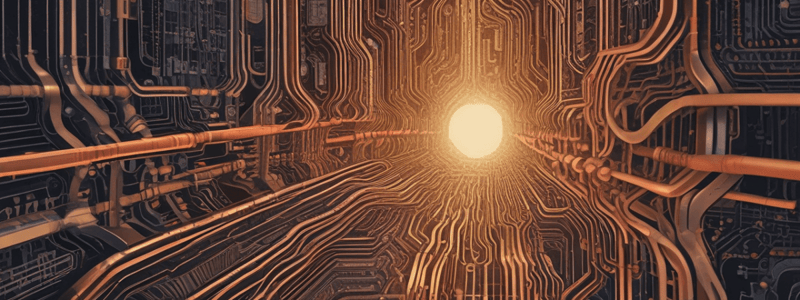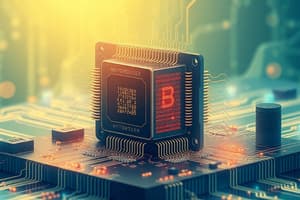Podcast
Questions and Answers
What is the purpose of generating control signals in a pipelined processor?
What is the purpose of generating control signals in a pipelined processor?
- To execute instructions
- To write results back to registers
- To decode instructions and produce control values (correct)
- To fetch instructions
Why do some control signals need to be propagated through the pipeline?
Why do some control signals need to be propagated through the pipeline?
- Because they are needed in a later stage and clock cycle (correct)
- Because they are generated too early
- Because they are not needed at all
- Because they are generated in the wrong stage
How are control signals propagated through the pipeline?
How are control signals propagated through the pipeline?
- Through a separate control signal bus
- Through a special control signal pipeline
- Through the pipeline registers, along with the other data (correct)
- Through the main memory
How are control signals categorized?
How are control signals categorized?
What control signals are needed in the MEM stage?
What control signals are needed in the MEM stage?
What is the purpose of the PCSrc control signal?
What is the purpose of the PCSrc control signal?
What is the function of the RegDst control signal?
What is the function of the RegDst control signal?
What is the purpose of the ALUSrc control signal?
What is the purpose of the ALUSrc control signal?
What is the purpose of the MemRead control signal?
What is the purpose of the MemRead control signal?
What is the purpose of the MemToReg control signal?
What is the purpose of the MemToReg control signal?
What is the purpose of propagating values forward in a pipelined datapath?
What is the purpose of propagating values forward in a pipelined datapath?
What is the function of the PCSrc signal in the pipelined datapath?
What is the function of the PCSrc signal in the pipelined datapath?
What is the purpose of the RegWrite signal in the pipelined datapath?
What is the purpose of the RegWrite signal in the pipelined datapath?
What is the function of the MemRead signal in the pipelined datapath?
What is the function of the MemRead signal in the pipelined datapath?
What is the purpose of the ALU in the pipelined datapath?
What is the purpose of the ALU in the pipelined datapath?
What is the purpose of the Shift Left 2 unit in the pipelined datapath?
What is the purpose of the Shift Left 2 unit in the pipelined datapath?
What is the purpose of the Sign Extend unit in the pipelined datapath?
What is the purpose of the Sign Extend unit in the pipelined datapath?
What is the purpose of the Instr [15-0] register in the pipelined datapath?
What is the purpose of the Instr [15-0] register in the pipelined datapath?
What is the purpose of the Instr [20-16] and Instr [15-11] registers in the pipelined datapath?
What is the purpose of the Instr [20-16] and Instr [15-11] registers in the pipelined datapath?
What is the purpose of the RegDst signal in the pipelined datapath?
What is the purpose of the RegDst signal in the pipelined datapath?
What is the main difference between the original single-cycle datapath and the modified datapath?
What is the main difference between the original single-cycle datapath and the modified datapath?
What determines the actual memory operation in the modified datapath?
What determines the actual memory operation in the modified datapath?
Why are the pipeline registers named after the stages they connect?
Why are the pipeline registers named after the stages they connect?
What is the reason for not having a register after the WB stage?
What is the reason for not having a register after the WB stage?
What is the purpose of adding intermediate registers to the pipelined datapath?
What is the purpose of adding intermediate registers to the pipelined datapath?
What is the main advantage of having separate memories for instructions and data?
What is the main advantage of having separate memories for instructions and data?
What is the instruction in the MEM stage?
What is the instruction in the MEM stage?
What is the operation performed in the EX stage?
What is the operation performed in the EX stage?
What is the purpose of the PCSrc signal?
What is the purpose of the PCSrc signal?
What is the register being written in the WB stage?
What is the register being written in the WB stage?
What is the operation performed in the ID stage?
What is the operation performed in the ID stage?
What is the purpose of the RegWrite signal?
What is the purpose of the RegWrite signal?
What is the address used in the lw instruction?
What is the address used in the lw instruction?
What is the purpose of the MemWrite signal?
What is the purpose of the MemWrite signal?
What is the main benefit of pipelining?
What is the main benefit of pipelining?
What is a characteristic of the MIPS instruction set that makes it easy to pipeline?
What is a characteristic of the MIPS instruction set that makes it easy to pipeline?
Why is pipelining harder for older, more complex instruction sets?
Why is pipelining harder for older, more complex instruction sets?
What is a consequence of having memory-to-memory instructions in an instruction set?
What is a consequence of having memory-to-memory instructions in an instruction set?
What is the relationship between the execution time of a single instruction and pipelining?
What is the relationship between the execution time of a single instruction and pipelining?
What is a characteristic of the MIPS instruction set that simplifies the pipeline?
What is a characteristic of the MIPS instruction set that simplifies the pipeline?
What is the result of pipelining on the execution time of a sequence of instructions?
What is the result of pipelining on the execution time of a sequence of instructions?
Why does pipelining improve throughput?
Why does pipelining improve throughput?
Flashcards are hidden until you start studying
Study Notes
Pipelining and Control Signals
- Control signals are generated after an instruction is fetched and decoded, producing appropriate control values.
- Control signals are categorized by the pipeline stage that uses them:
- EX stage: ALUSrc, ALUOp, RegDst
- MEM stage: MemRead, MemWrite, PCSrc
- WB stage: RegWrite, MemToReg
Pipeline Registers and Datapath
- Control signals are propagated through pipeline registers along with other data.
- The datapath components have been moved around in preparation for adding pipeline registers.
- Separate memories are used for instructions and data.
- There are two adders for PC-based computations and one ALU.
- The control signals are the same as in the single-cycle processor.
Propagating Values Forward
- Data values required in later stages must be propagated through the pipeline registers.
- Almost all components are the same as in the original single-cycle datapath, with some cosmetic changes.
Pipeline Registers
- Intermediate registers are added between each stage of the pipeline.
- The registers are named for the stages they connect: IF/ID, ID/EX, EX/MEM, and MEM/WB.
The Pipelining Paradox
- Pipelining does not improve the execution time of a single instruction, but increases throughput.
- Each instruction takes longer to execute than in a single-cycle datapath, but the result is improved execution time for a sequence of instructions.
Instruction Set Architectures and Pipelining
- The MIPS instruction set was designed for easy pipelining.
- All instructions are 32-bits long, which simplifies the instruction fetch stage.
- Fields are in the same position in different instruction formats, making it easy for the ID stage.
- MIPS is a register-to-register architecture, which keeps the pipeline simpler.
- Pipelining is harder for older, more complex instruction sets.
Studying That Suits You
Use AI to generate personalized quizzes and flashcards to suit your learning preferences.




